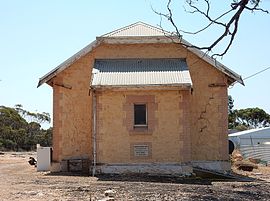Warramboo, South Australia
| Warramboo South Australia | |||||||||||||||
|---|---|---|---|---|---|---|---|---|---|---|---|---|---|---|---|
 Warramboo Methodist Church | |||||||||||||||
 Warramboo | |||||||||||||||
| Coordinates | 33°14′24″S 135°35′42″E / 33.24000°S 135.59500°ECoordinates: 33°14′24″S 135°35′42″E / 33.24000°S 135.59500°E[1] | ||||||||||||||
| Population | 108 (2016 census)[2] | ||||||||||||||
| Established | 19 July 1917 (town) 11 November 1999 (locality)[3][4] | ||||||||||||||
| Postcode(s) | 5650[5] | ||||||||||||||
| Time zone | ACST (UTC+9:30) | ||||||||||||||
| • Summer (DST) | ACST (UTC+10:30) | ||||||||||||||
| Location | |||||||||||||||
| LGA(s) | Wudinna District Council[1] | ||||||||||||||
| Region | Eyre Western[1] | ||||||||||||||
| County | Le Hunte[1] | ||||||||||||||
| State electorate(s) | Flinders[6] | ||||||||||||||
| Federal Division(s) | Grey[7] | ||||||||||||||
| |||||||||||||||
| |||||||||||||||
| Footnotes | Adjoining localities[1] | ||||||||||||||
Warramboo (wɔrˑræmˑbʉː) is a locality in the Australian state of South Australia located on the Eyre Peninsula about 334 kilometres (208 mi) north-west of the state capital of Adelaide and about 26 kilometres (16 mi) south-east of the municipal seat of Wudinna.[5][1] It is 189 kilometres (117 mi) north of Port Lincoln on the Tod Highway and is the north-western terminus of the wheat haulage lines radiating from Port Lincoln on the Eyre Peninsula Railway.[9] The railway line was built from 1907–1915 to develop the cereal industry.[9] The grain silos are a distinctive local landmark of the town.[citation needed]
At the 2006 census, Warramboo and the surrounding area had a population of 248.[2] Warramboo has little in the way of services, with no shops or petrol stations. However, the local post office still services the local community, which is mainly engaged in agriculture.[citation needed] Warramboo has one of the largest (historical) windmills in the southern hemisphere, located ~10 km west of the township and still present today.[citation needed] The water from this mill was unfortunately not suitable for people or livestock due to the high salt concentration.[citation needed]
History[]
The traditional inhabitants of the Warramboo district and much of the South-West region of Eyre Peninsula are the Nawu/Nauo people. The word 'warramboo' means 'a lake/place of water', referring to the prevalence of samphire swamps in the region.[10]
A public school was erected at Warramboo during early European settlement and remained a source of education for children 5–12 years old from 1920 until its closure in 2002.[citation needed] The town hall was also built in the 1920s.[citation needed] The original wood and iron hall was demolished and a new stone hall built in its place in 1934.[11]
The local Australian rules football team (Central Eyre Football Club) was formed from an amalgamation of the Warramboo and Kyancutta Football Clubs in 1986. The Central Eyre Football Club was one of six teams in the Mid West Football League.[citation needed]
Mining proposal[]
Iron Road Limited has plans to develop a magnetite mine and infrastructure near Warramboo.[12]: 24 The Central Eyre Iron Project is planned to produce a high quality, low impurity iron concentrate for steel manufacturers, at an output of 24 million tonnes per annum of approximately 67 per cent iron concentrate over almost 30 years. The company has acquired land for a new deep water port at Cape Hardy on the western shore of Spencer Gulf, which would be connected to Warramboo by a 148 kilometres (92 mi) utilities corridor in which would be a substantial standard gauge heavy haul railway, service road, power line and water pipeline.[13][14]
See also[]
- Cocata Conservation Park
- Iron Road Ltd
References[]
- ^ Jump up to: a b c d e f g h "Search results for "Warramboo, Locb" with the following datasets selected - 'Suburbs and Localities', 'Counties', 'Government Towns', 'Hundreds', 'Local Government Areas', 'SA Government Regions' and 'Gazetteer'". Location SA Map Viewer. Government of South Australia. Retrieved 6 April 2020.
- ^ Jump up to: a b Australian Bureau of Statistics (25 October 2007). "Warramboo (State Suburb)". 2006 Census QuickStats. Retrieved 7 September 2011.
- ^ Peake, A.H. (19 July 1917). "Town of Warramboo" (PDF). The South Australian Government Gazette. Government of South Australia. p. 109. Retrieved 6 April 2020.
- ^ Kentish, Peter Maclaren (11 November 1999). "GEOGRAPHICAL NAMES ACT 1991 Notice to Assign Names and Boundaries to Places ( within the District Council of Le Hunte)" (PDF). The South Australian Government Gazette. Government of South Australia. p. 2321. Retrieved 6 April 2020.
- ^ Jump up to: a b c "Warramboo, South Australia (Postcode)". postcodes-australia.com. Retrieved 6 January 2017.
- ^ "District of Flinders Background Profile". Electoral Commission SA. Retrieved 9 September 2015.
- ^ "Federal electoral division of Grey" (PDF). Australian Electoral Commission. Retrieved 24 July 2015.
- ^ Jump up to: a b c "Monthly climate statistics: Summary statistics KYANCUTTA (nearest weather station)". Commonwealth of Australia , Bureau of Meteorology. Retrieved 6 January 2017.
- ^ Jump up to: a b Twidale, C.R. (1985). Natural History of Eyre Peninsula. Northfield, SA: Royal Society of South Australia (Inc). p. 229. ISBN 0-9596627-3-1.
- ^ State Library, South Australia. "The Manning Index of South Australia History". Department for Environment and Heritage, South Australia. Retrieved 26 May 2011.
- ^ Franklin, Erna (1986). Grain Amid Granite: Official History of the District Council of Le Hunte, including the Minnipa-Wudinna district. Wudinna: District Council of Le Hutne. p. 260. ISBN 1-86252-075-5.
- ^ Iron Road annual report 2017. Adelaide: Iron Road Limited. 30 June 2017.
- ^ Stocks, Andrew (23 May 2017). "Iron Road presentation to SA Resources & Energy Investment Conference 2017". Iron Road. Iron Road Ltd. Retrieved 25 October 2017.
- ^ https://www.ironroadlimited.com.au/central-eyre-iron-project
- Towns in South Australia
- Eyre Peninsula
